The name Heracleion evokes a sense of wonder and mystery, doesn’t it?
Once a thriving hub along the Mediterranean coast, this city vanished beneath the waves, leaving behind an enduring enigma.
Its rediscovered ruins and artifacts whisper tales of grandeur, yet many questions about its fate remain unanswered.
In this article, we will delve into the discovery of Heracleion, uncover its hidden secrets, and explore the urban legends that surround it.
How did this majestic city sink into the depths of the sea, and what truths does it have to reveal?
Join us on this epic journey to uncover the mysteries of the lost city of Heracleion.
- The Historical Discovery of Heracleion
- The Structure of the Sunken City in the Mediterranean
- The Cultural Legacy of the Ancient City
- Urban Legends and Truths About Heracleion
- Reflecting on the Mysteries of Heracleion
The Historical Discovery of Heracleion
Heracleion was long considered a mythical city.
The discovery of this ancient city was only confirmed in the 1990s.
Until then, many believed it was merely part of myths or exaggerated history.
The story of how it was discovered is a fascinating fusion of science and exploration.
Legends of Heracleion and Questions of Its Existence
The name Heracleion first appeared in the writings of the ancient Greek historian Herodotus.
According to his accounts, the city served as a major religious and trade hub.
However, specific evidence proving its existence and location remained elusive for centuries.
As a result, historians and archaeologists often regarded Heracleion as a part of myth or urban legend.
The Path to Discovery
The journey to uncover Heracleion involved years of trial and effort.
In the late 1990s, a team led by French marine archaeologist Franck Goddio began exploring Aboukir Bay in Egypt.
Using cutting-edge sonar technology and magnetic survey devices, they detected anomalies on the seabed suggesting man-made structures.
Subsequent dives revealed city ruins, finally bringing Heracleion to light.
Massive Structures Unearthed Beneath the Sea
Excavations at Heracleion uncovered astonishing structures.
Among the highlights were statues over five meters tall and temple ruins.
These structures showcased a blend of ancient Egyptian and Greek cultural designs, signifying their use in religious ceremonies.
Numerous gold coins, jewels, trade goods, and even sunken ships further illustrated the city’s thriving trade.
Details of the Temple
The temple was believed to be dedicated to the Egyptian gods Amun and Hapi.
Its foundations were made of granite, and its columns bore hieroglyphic inscriptions.
Excavated altars revealed golden ornaments and ceremonial vessels.
These findings highlight Heracleion’s significance as not just a trade hub but also a vital religious center.
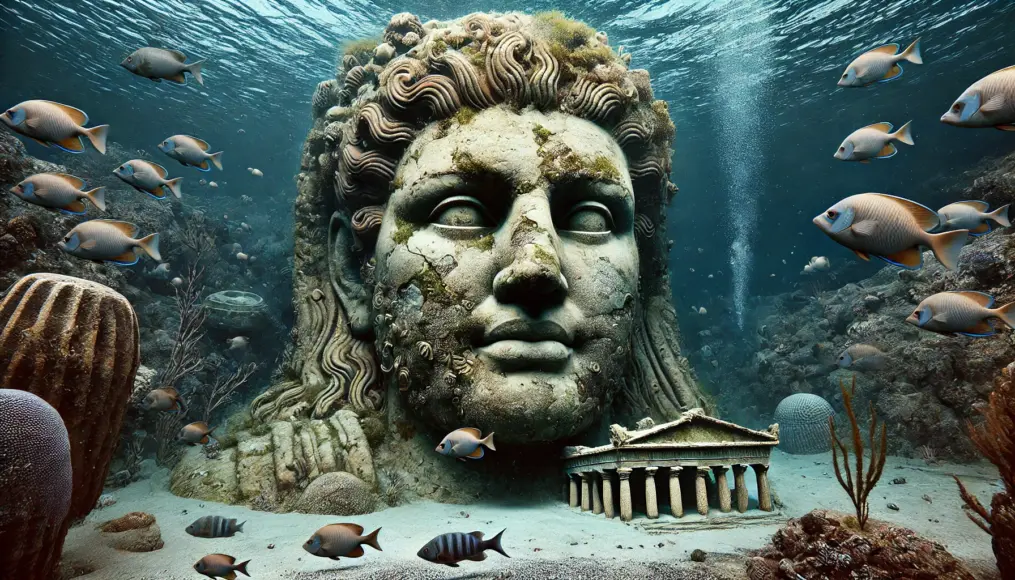
The Mystery of the Giant Statues
The massive statues discovered were representations of Egyptian gods and royalty.
These statues demonstrated advanced carving techniques and symbolized religious authority.
Traces of paint found on the statues suggest they were once vividly decorated.
It is possible the colors were refreshed during rituals or seasons, offering a glimpse into ancient religious practices.
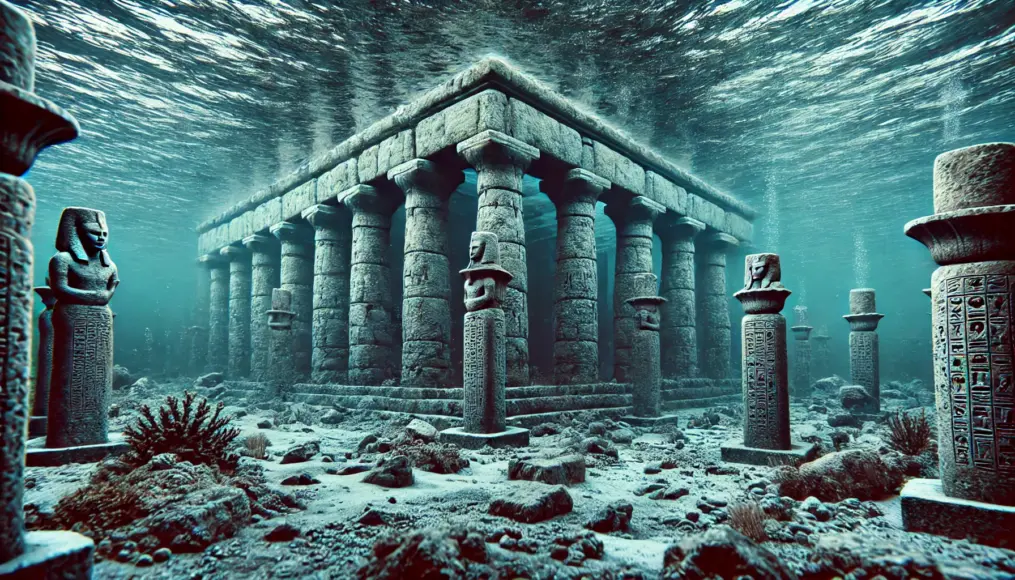
Why Did It Sink? The Mediterranean’s Hidden Mystery
The reason for Heracleion’s submersion remains partially unresolved.
Geologists suggest subsidence and tsunamis as likely causes.
The region is seismically active, and such natural disasters could have engulfed the city beneath the waves.
These factors may have hidden Heracleion for thousands of years.
Impact of Land Subsidence
The Nile Delta, where Heracleion was located, was geologically unstable.
Long-term crustal movements and water erosion likely caused the land to sink.
The weight of the city’s structures may have accelerated the subsidence process.
A tsunami occurring during this period could have quickly buried the city underwater.
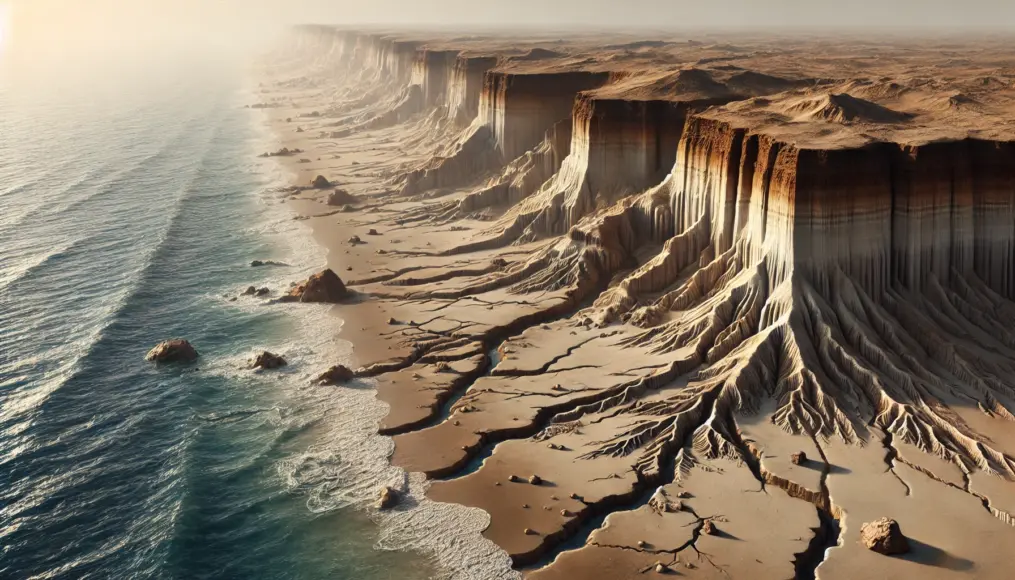
Possible Tsunamis
Records suggest a massive tsunami struck the area around the 2nd century BCE.
This event devastated coastal cities, possibly including Heracleion.
The tsunami likely submerged the city, leaving it buried under mud and sand for centuries.
Natural phenomena like these may have inspired the urban legends surrounding Heracleion’s disappearance.
The Structure of the Sunken City in the Mediterranean
Heracleion, which had been submerged in the Mediterranean seabed for about 1,200 years, was an archaeological sensation when discovered.
The city, preserved in remarkable condition underwater, reveals traces of an ancient civilization.
Heracleion stands out not just as a sunken city but as a treasure trove of culture and history due to its vast city structure and unique design.
Here, we delve into the structure of this underwater city and uncover its captivating charm.
The Grand Temple at the City’s Heart
At the center of Heracleion was a grand temple dedicated to the Egyptian god Amun-Ra.
The temple, built of limestone, featured columns and carvings characteristic of Egyptian architecture.
The carvings depicted scenes of mythology and rituals, suggesting that religious ceremonies were deeply rooted in the city’s life.
The architectural style of this temple is considered evidence of the intersection of Egyptian and Greek cultures.
The Social Role of the Temple
This temple was not only a religious hub but also a center for politics and economics.
Ceremonies held at the temple were reportedly attended by city leaders and foreign traders.
According to inscriptions and records, many trade agreements were made here, highlighting its role in the region’s economic activities.
The temple was more than a religious structure; it was a symbol of the city itself.
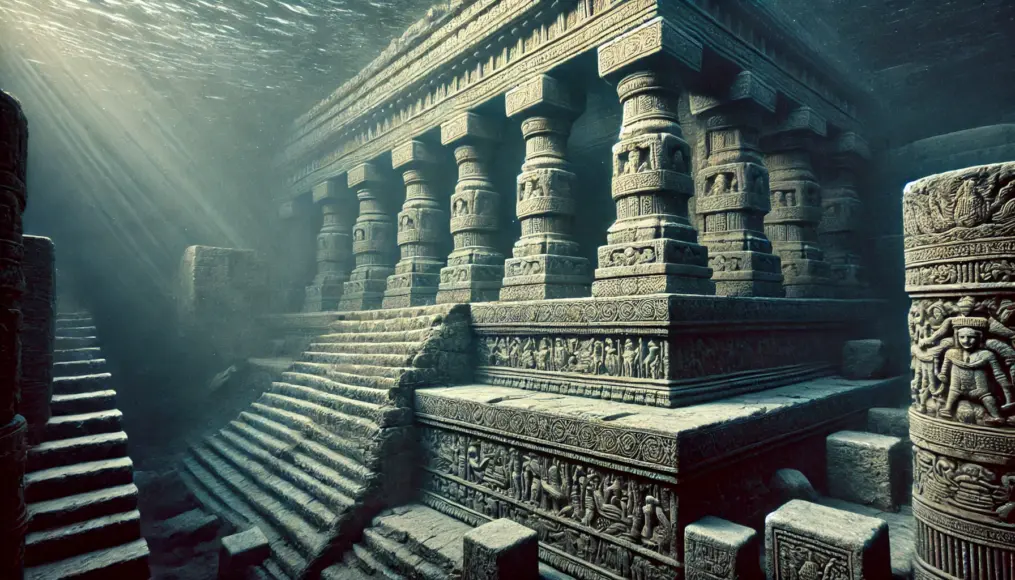
Port Facilities and the Hub of Trade
Heracleion’s port facilities were highly developed, with extensive docks and mooring spots for ships.
These facilities featured stone breakwaters and pulleys for loading cargo, showcasing efficient design.
The city was a key hub for ancient Mediterranean trade, attracting many ships.
Discovered anchors and pottery cargo testify to the city’s prosperity.
Cultural Exchange Through Trade
Heracleion was a vital point on the trade route connecting Egypt and Greece, facilitating significant cultural exchange.
Greek coins and Egyptian ornaments found in the ruins indicate traces of cultural fusion.
Goods like gold, silver, spices, and textiles were traded here, underscoring the city’s economic importance in the region.
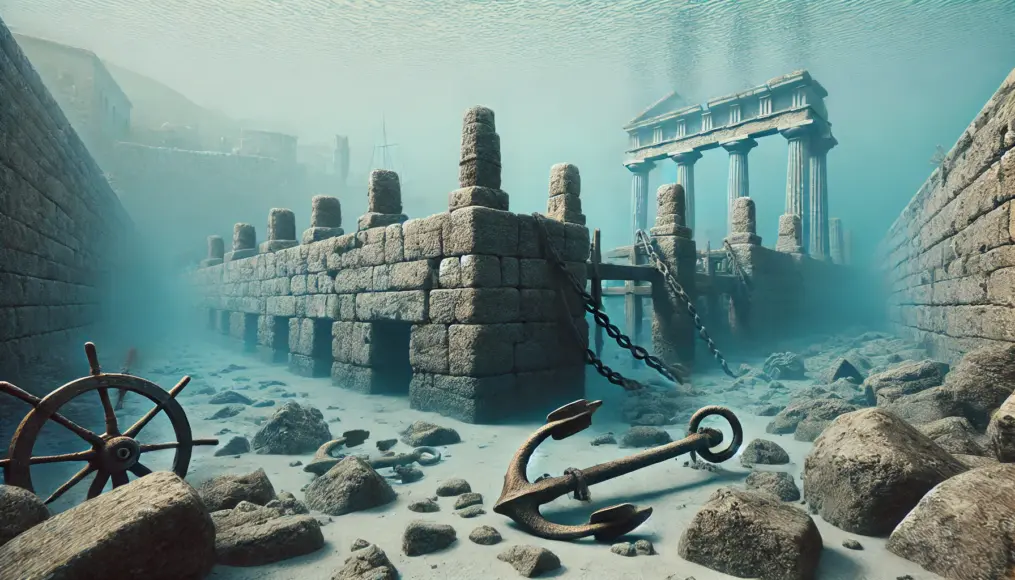
Marketplaces and Residential Areas
Market ruins in the city center have yielded numerous gold coins, silver coins, and pottery, revealing Heracleion’s vibrant commercial activity.
The market was centrally located, surrounded by warehouses and merchants’ trading posts.
These areas likely handled a wide variety of goods, from local agricultural products to imported items.
The bustling market symbolized the city’s overall prosperity.
Traces of Daily Life in Residential Areas
The city housed many stone-built residences, and artifacts like pottery, furniture fragments, and ornaments were discovered inside them.
Notably, cooking utensils and tableware offer insights into the culinary and daily habits of its residents.
Such artifacts confirm that Heracleion was not merely a trade hub but a populated residential city.
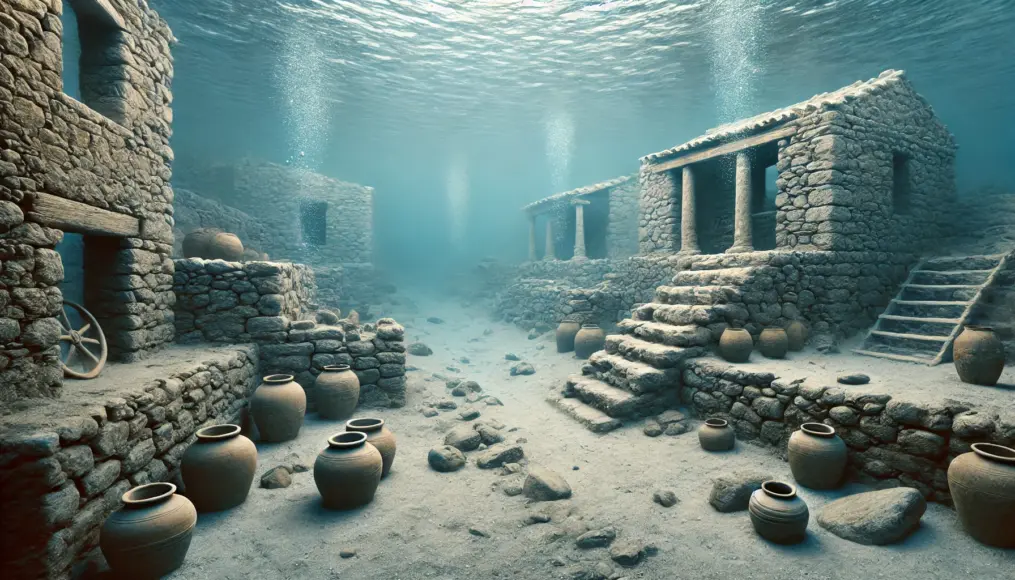
Defense Facilities Highlight Strategic Importance
High walls and watchtowers surrounded Heracleion’s outskirts, underscoring the importance of city defense.
These defense systems were designed to prevent external invasions and maintain order within the city.
Particularly around the port, robust defense facilities ensured the safety of trade.
These features contributed significantly to the city’s prosperity and survival.
Strategic Value Behind Defense Systems
Located at a crucial point connecting Egypt and the Mediterranean world, Heracleion held strategic importance.
The design of the defense facilities showcased advanced engineering skills of the time, and their robustness remains evident even today.
Such structures demonstrate that the city was not just a trade hub but also a militarily valuable site.
The defense systems ensured the city’s safety while extending its influence over the region.
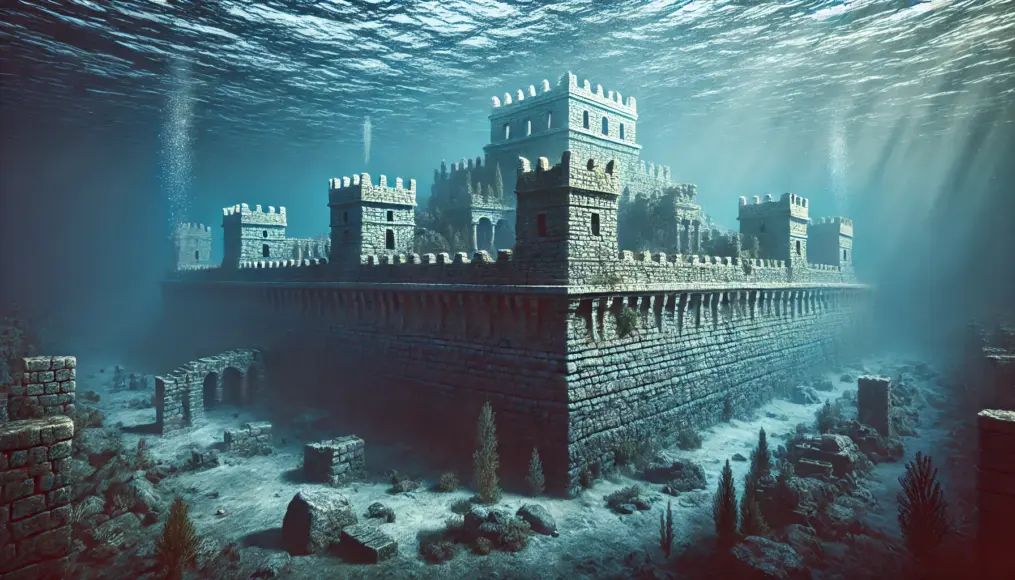
The structure of Heracleion sets it apart from other sunken cities with its unique design and cultural background.
These ruins are not merely remnants of history but essential evidence of the sophistication of ancient civilizations.
The Cultural Legacy of the Ancient City
The cultural legacy of Heracleion holds great significance for the study of history and civilization.
This ancient city functioned as a hub for trade and cultural exchange centered around the Mediterranean.
The discovered artifacts provide clues about how ancient people lived and what they believed in.
As a place where Egyptian and Greek cultures intersected, Heracleion reflects the profound influences of both civilizations.
Understanding how this city thrived and ultimately sank allows us to unravel the mysteries of the past.
The Diversity of Discovered Artifacts
Artifacts excavated from the underwater ruins of Heracleion exhibit incredible diversity.
Among these are gold and silver ornaments, as well as sacred tools used in religious rituals.
One of the most remarkable findings is a giant statue of the Egyptian god Osiris.
The statue’s intricate carvings highlight a level of craftsmanship that amazes even modern-day experts.
Gold and Silver Jewelry
The jewelry includes intricate goldsmithing and ornaments embedded with precious stones.
These pieces reveal insights into the cultural background of the upper class of the time.
Many of the ornaments also feature religious motifs, demonstrating how faith influenced everyday life.
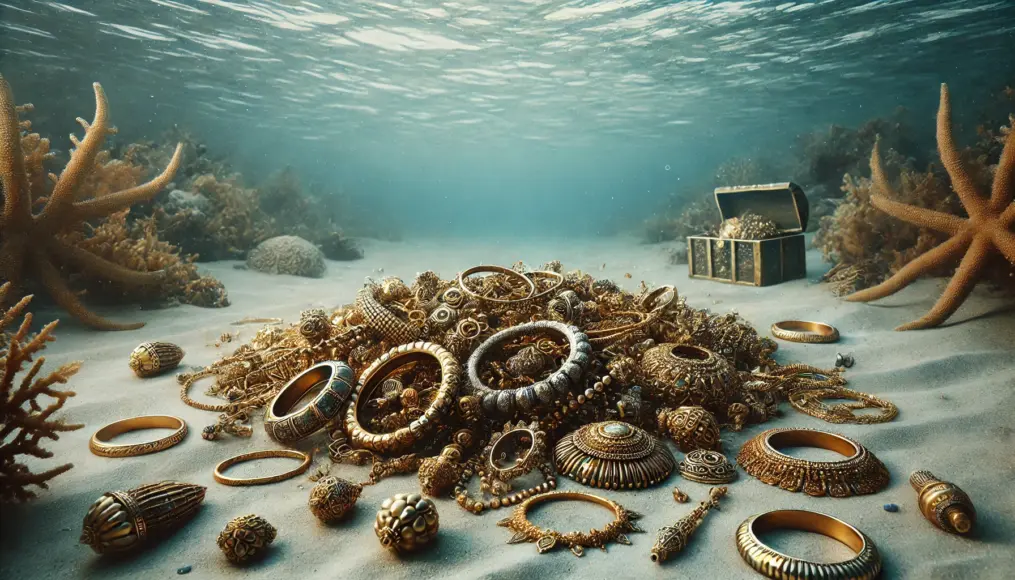
The Giant Osiris Statue
The Osiris statue serves as a symbol of Heracleion’s religious significance.
Reaching a height of 4 meters, it showcases a blend of Egyptian and Greek sculptural techniques.
Its detailed carvings represent deep reverence for the gods, transcending mere decoration.
The statues also narrate how people of the time connected nature with divinity.
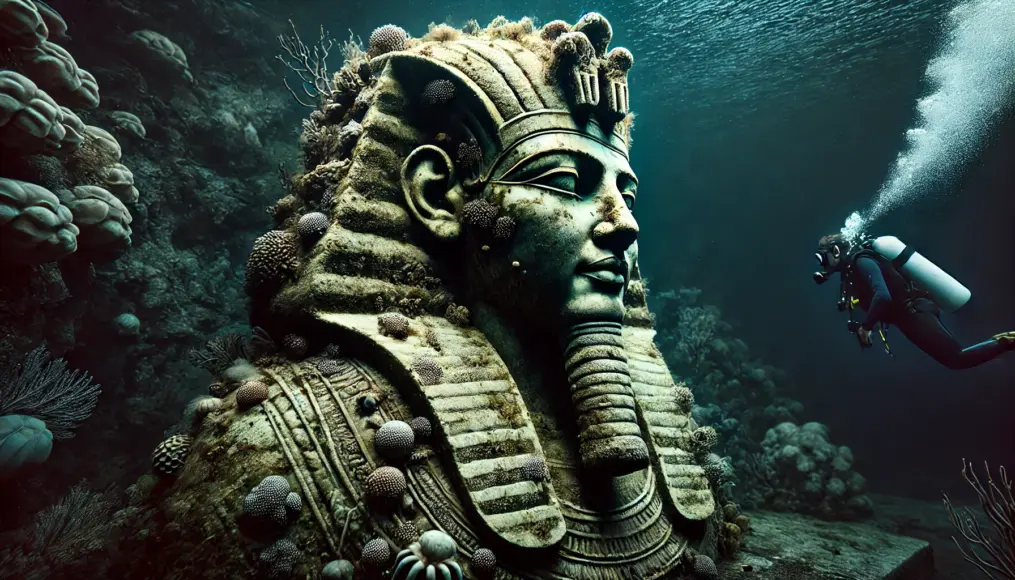
Religious Role of Heracleion
Heracleion was known for frequent religious rituals.
The city reportedly housed a grand temple dedicated to the god Amun, with its foundation unearthed underwater.
This temple, based on Egyptian architectural styles while incorporating Greek design elements, symbolizes cultural integration.
Stelae discovered near the temple record details of rituals and forms of worship shared by Egyptians and Greeks.
Architectural Style of the Amun Temple
The temple structure features grand designs utilizing massive stone materials.
Its columnar structure, unique to Egyptian architecture, integrates Greek sculptural aesthetics.
This combination signifies not just a religious space but also a cultural exchange symbol.
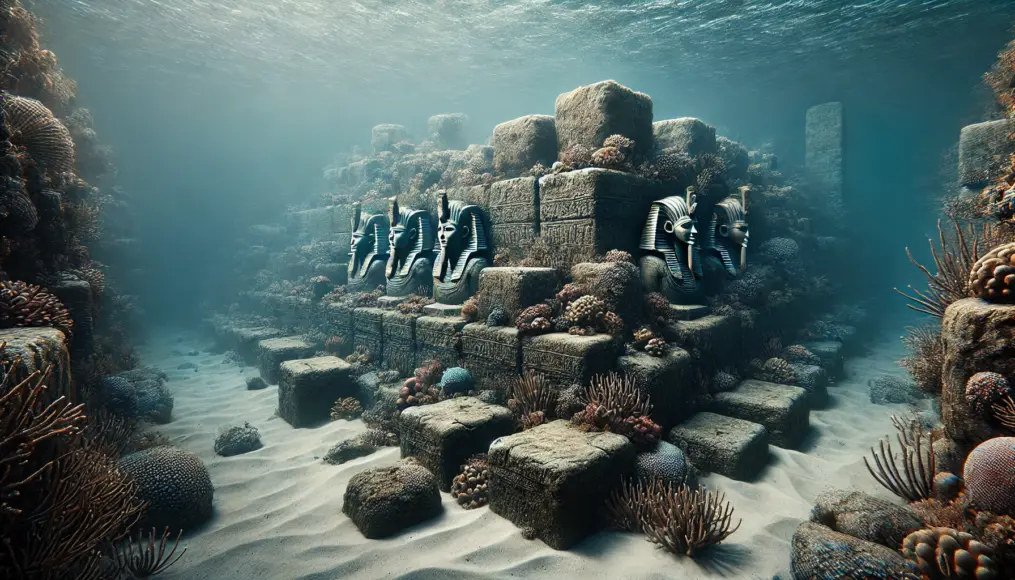
Ritual Tools
Many tools believed to be used in rituals have been found around the temple.
These tools incorporate symbols from both Egyptian and Greek cultures, illustrating their shared religious practices.
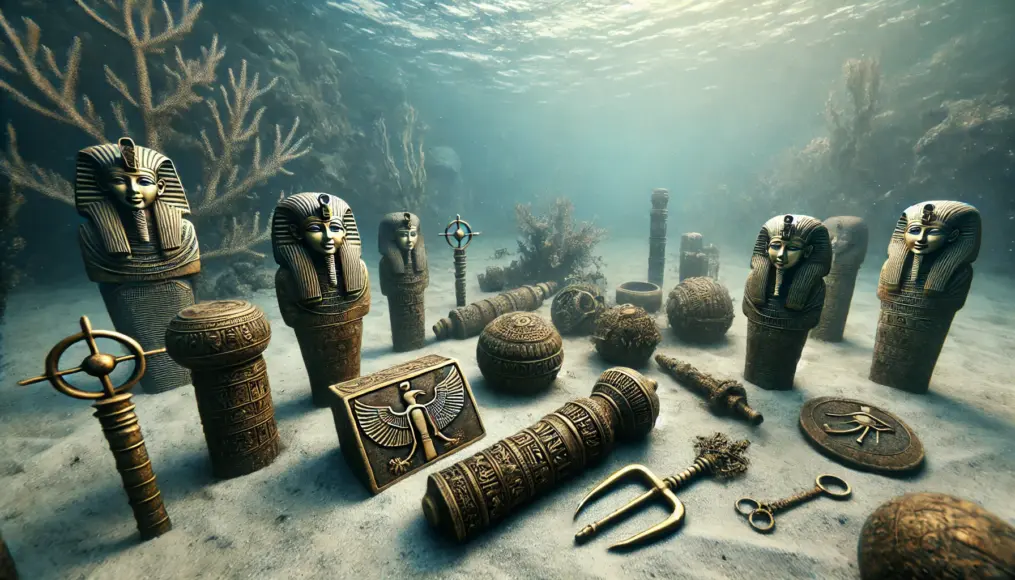
Heracleion as a Trade Hub
Heracleion served as both a religious center and a bustling trade hub.
The city maintained a trade network across the Mediterranean, evidenced by unearthed pottery and coins.
Artifacts from Greece and Phoenicia demonstrate active cultural exchange and economic activity.
Additionally, remnants of port facilities reveal advanced maritime techniques of the era.
Unearthed Pottery and Coins
The pottery includes uniquely Greek designs, alongside high-quality items from Phoenicia.
Coins signify widespread trade activities, highlighting the city’s economic prosperity.
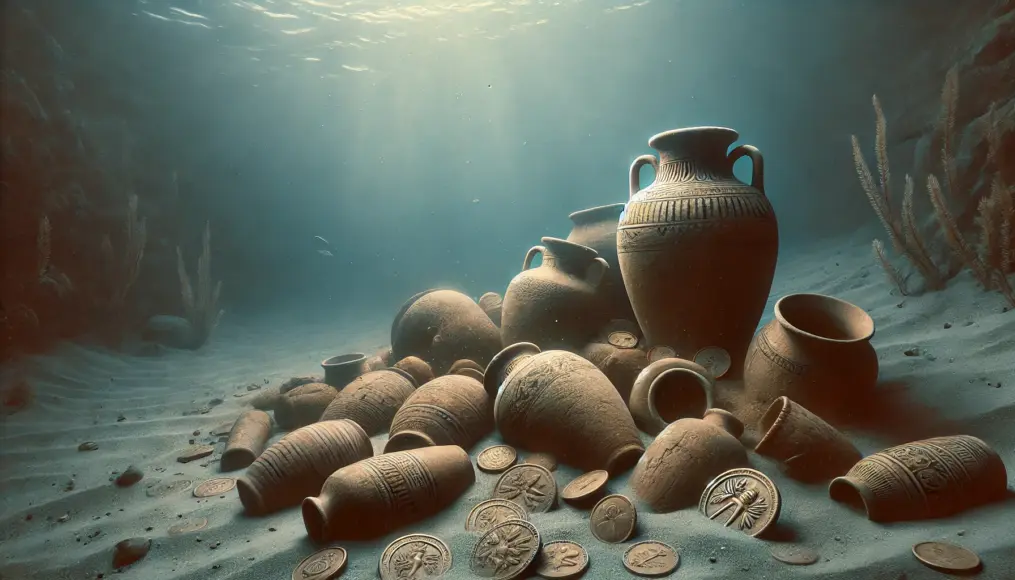
Port Facility Structure
The excavated port facilities underline Heracleion’s importance as a trade hub.
Stone-built piers and storage facilities found underwater illustrate its remarkable scale.
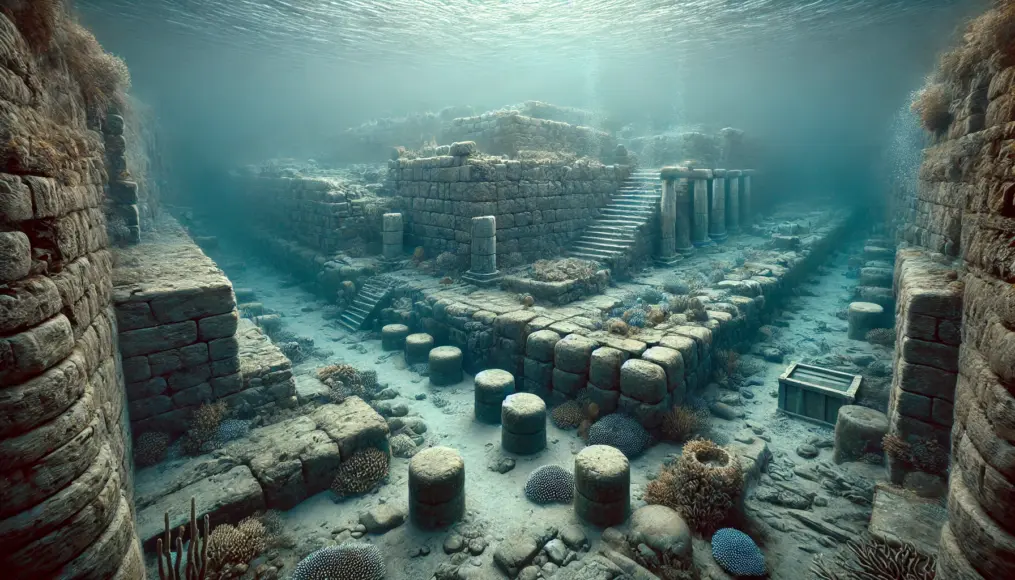
Heracleion’s cultural legacy extends beyond historical artifacts.
It symbolizes the lives, beliefs, and cultural synthesis of ancient people, continuing to inspire us today.
Urban Legends and Truths About Heracleion
Heracleion had long been shrouded in mystery as a lost city of the ancient world.
Its discovery shed light on an ancient civilization but also revealed numerous unexplained enigmas.
The stories told in ancient texts and the legends surrounding its discovery continue to captivate people worldwide.
Let’s delve deeper into the mysteries and urban legends that surround Heracleion.
Ancient Texts Describe the “Sunken City”
In ancient records, Heracleion is depicted as a hub of trade and religious activity.
Its name appears in the writings of Greek historian Herodotus, portraying it as a city deeply intertwined with Egyptian culture.
Notably, it was said to be a sacred site dedicated to Hercules, with its name deriving from the revered god.
However, accounts of its submersion vary between texts, leaving its ultimate fate unresolved.
Theories on the Cause of Submersion
Some ancient texts attribute the submersion of Heracleion to earthquakes or tsunamis, while others lean on mythological explanations.
For instance, tales of “the wrath of the gods” consuming the city reflect the era’s religious sentiments.
Another theory suggests the flooding of the Nile River played a role, though the scale and frequency remain unclear.
The interplay of natural phenomena and mythology deepens the mystery of Heracleion.
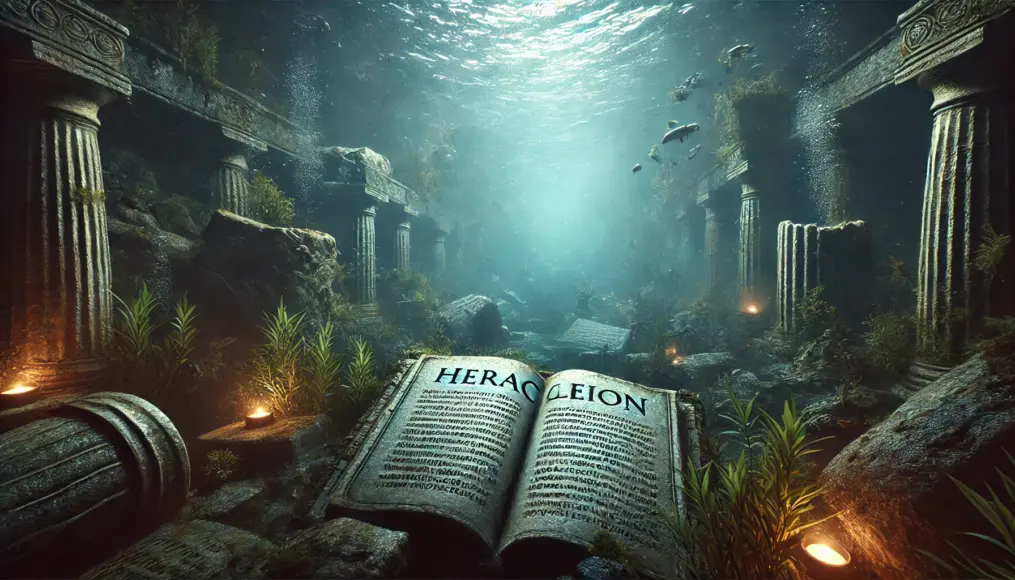
Predictions of Submersion in Ancient Writings
Some scholars focus on ancient, prophetic descriptions linked to Heracleion.
Expressions like “the reversal of water and land” are thought to symbolize the city’s tragic destiny.
Such cryptic writings have fueled modern urban legends surrounding the city.
The intertwining of prophecy and reality adds an alluring mystique to Heracleion.
The “Curse of Heracleion” Following Its Discovery
The discovery of Heracleion was a milestone in archaeology, yet the events that followed garnered even greater intrigue.
Reports of misfortunes and eerie experiences among researchers and divers have created a narrative of a “curse.”
This so-called curse, tied to Heracleion, continues to fascinate and divide opinions.
Is it coincidence, or could there be an unknown force at work?
Misfortunes of the Discoverers
Several archaeologists who studied Heracleion reported falling ill under mysterious circumstances.
Others involved in retrieving artifacts faced accidents and unusual troubles, sparking widespread rumors.
The media and local communities have amplified these stories, cementing the legend of a curse.
Whether factual or not, these tales contribute significantly to the city’s allure as an urban legend.
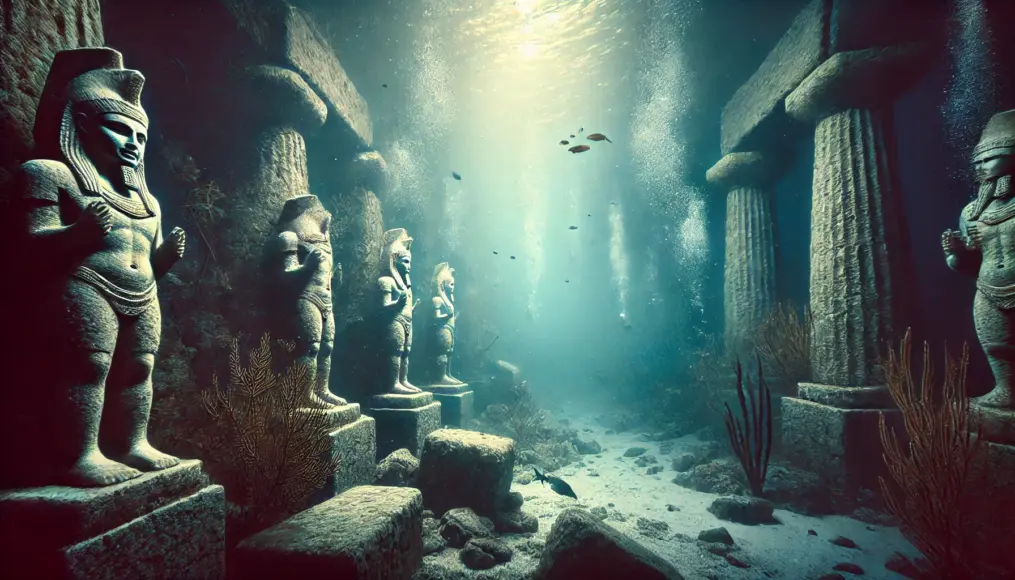
Investigating the Source of the Curse
Some experts suggest that the so-called curse may stem from psychological factors.
The stress of working in unknown environments and the mystique of handling ancient relics might amplify such experiences.
Conversely, local beliefs attribute these events to “the wrath of Heracleion’s gods.”
The convergence of scientific and mythological interpretations enhances the allure of this legend.
New Mysteries Arise from Unsolved Questions
Research on Heracleion continues, leaving many unanswered questions about the city.
Artifacts unearthed include undeciphered inscriptions and hieroglyphs that remain enigmatic.
The meanings behind these discoveries remain unknown, awaiting future breakthroughs.
These unsolved elements act as fertile ground for new urban legends.
The Potential of Future Discoveries
Advancements in technology have significantly improved underwater exploration capabilities.
These improvements may finally reveal the complete story of Heracleion in the near future.
However, as new discoveries are made, they often spark further questions and speculations.
How much of the city’s truth can truly be uncovered, and how many mysteries will remain hidden?
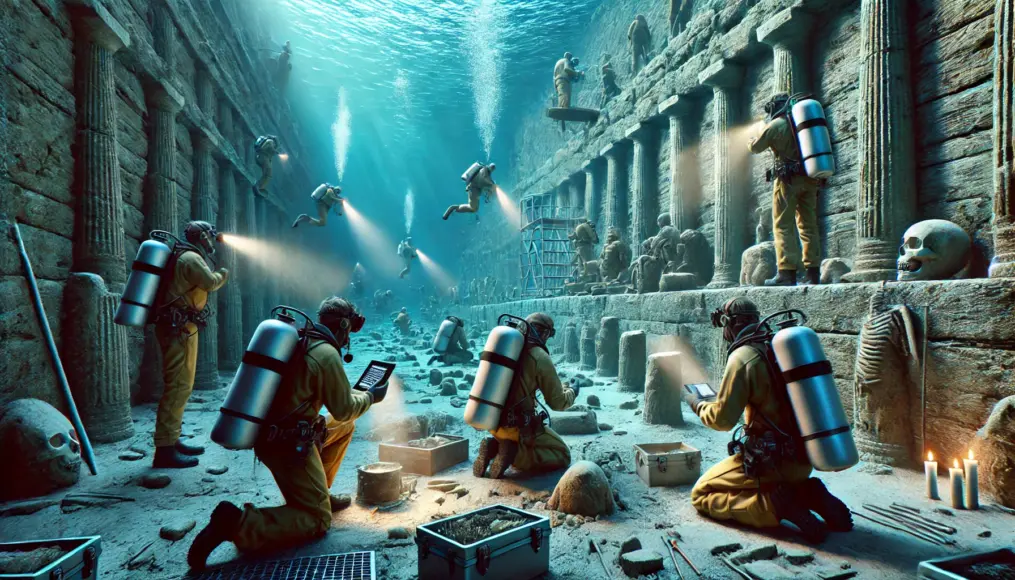
Reflecting on the Mysteries of Heracleion
Heracleion, submerged beneath the Mediterranean Sea, is far more than just an ancient city.
Its discovery delivered a historic shock, the unearthed artifacts provided immense cultural value, and numerous unresolved mysteries continue to captivate us.
This city, while influenced by ancient Egypt, carved out its own path to prosperity and reminds us of the diversity and complexity of past civilizations.
Yet, many questions remain unanswered.
Why did this city sink into the sea?
Are there more significant relics hidden beneath the Mediterranean seabed?
And what lessons can these ruins teach us in the modern era?
The key to unraveling these mysteries may lie not only in scientific investigation but also in the imagination of each one of us.
Within the tales often told as urban legends, could there be fragments of truth waiting to be uncovered?
What are your thoughts on Heracleion?
Feel free to share your impressions and opinions in the comments!
Your insights could spark new discussions or lead to fresh discoveries.

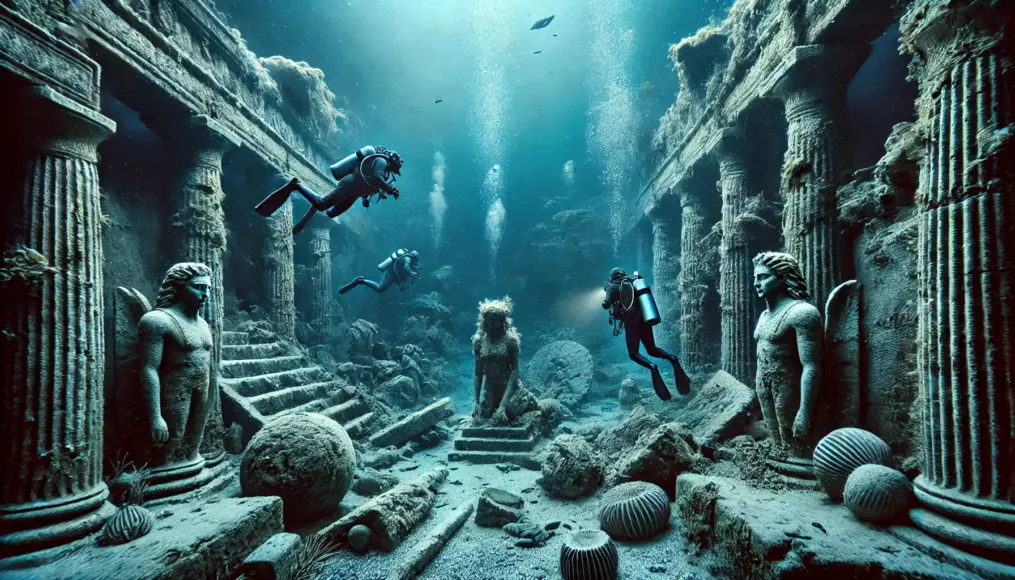
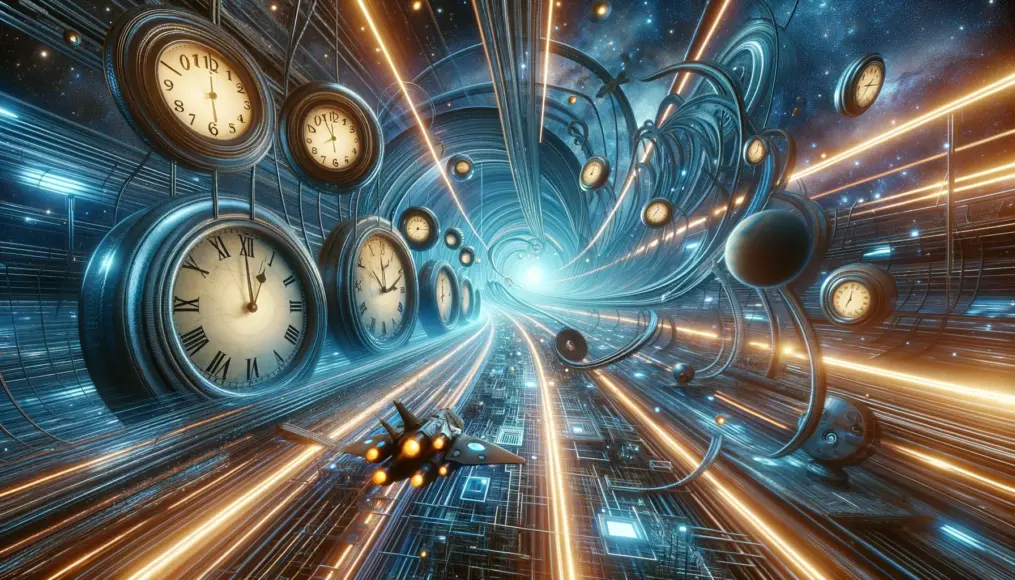

Comment